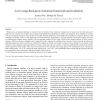Free Online Productivity Tools
i2Speak
i2Symbol
i2OCR
iTex2Img
iWeb2Print
iWeb2Shot
i2Type
iPdf2Split
iPdf2Merge
i2Bopomofo
i2Arabic
i2Style
i2Image
i2PDF
iLatex2Rtf
Sci2ools
130
click to vote
PR
2008
2008
A two-stage head pose estimation framework and evaluation
Head pose is an important indicator of a person's focus of attention. Also, head pose estimation can be used as the front-end analysis for multi-view face analysis. For example, face recognition and identification algorithms are usually view dependent. Pose classification can help such face recognition systems to select the best view model. Subspace analysis has been widely used for head pose estimation. However, such techniques are usually sensitive to data alignment and background noise. In this paper a two-stage approach is proposed to address this issue by combining the subspace analysis together with the topography method. The first stage is based on the subspace analysis of Gabor wavelets responses. Different subspace techniques were compared for better exploring the underlying data structure. Nearest prototype matching with Euclidean distance was used to get the pose estimate. The single pose estimate was relaxed to a subset of poses around it to incorporate certain tolera...
Related Content
| Added | 14 Dec 2010 |
| Updated | 14 Dec 2010 |
| Type | Journal |
| Year | 2008 |
| Where | PR |
| Authors | Junwen Wu, Mohan M. Trivedi |
Comments (0)

